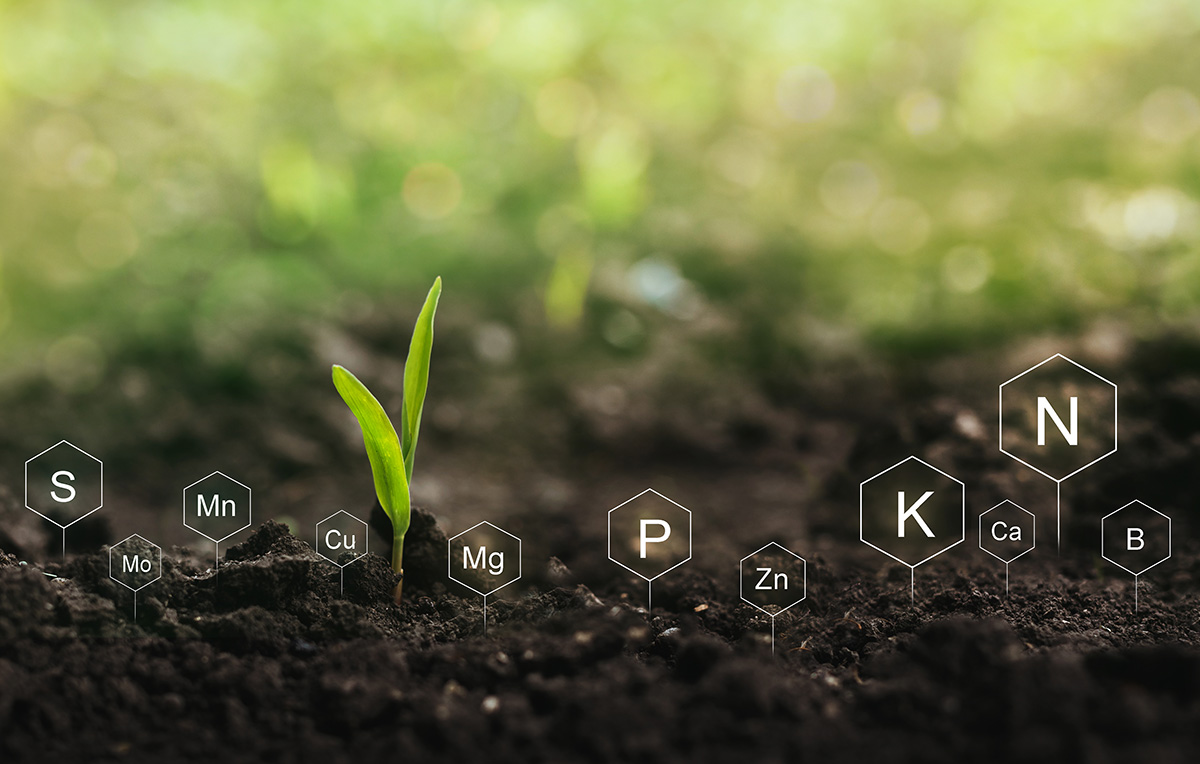Choose Turfgrass Nutrient Sources
Below you’ll find a list of nutrient sources, products, and soil amendments that can be used to add nutrients and organic matter and change the pH of your lawn. This makes nutrients more available to your plants.

A variety of primary and secondary nutrients are necessary for healthy soil. | Photo Credit: Shutterstock
Controlled Release Fertilizer
Release rate is an important consideration in selecting a fertilizer. Quality nitrogen fertilizers should contain controlled-release nitrogen. You can find out by checking the guaranteed analysis section on the back of the bag. Key terms to look for include controlled-release, slow-release, slowly-available, or water-insoluble nitrogen. Slow release fertilizers reduce the likelihood of nutrients running off into nearby lakes and streams. However, controlled release fertilizers won’t have that immediate “greening up” effect.
Organic Fertilizers
Many organic fertilizers come from animal sources but can also include plant and mineral sources. They usually contain low concentrations of nutrients. If the three nutrient analysis numbers (N-P-K) add up to more than 15, it is possible that you are dealing with a synthetic source of fertilizer, so be sure to check the bag carefully.
One of the advantages of organic sources of nitrogen (N) is the low chance of burning grass. If you can’t find organic fertilizer at your local nursery or homecare center, ask them to stock it. Otherwise, there are many options available online.
Organic Fertilizers and Amendments
Compost
Compost
Compost is the heart of natural lawn care because it increases organic material, delivers nutrients, improves water retention, balances pH, and creates an excellent bed for seeds. You can make compost at home, or buy it in bags or bulk. Compost is an excellent addition to improve soil quality, as it does so much more than simply add nutrients. Read more about compost here.
Compost Tea
Compost tea is a liquid form of compost that contains a lot of soil microbes. Microbes are an important part of soil because they activate nutrients in the soil. Use this brew as often as you like; compost tea can be either bought or home-made.
Plant By-Products
Corn Gluten
Corn gluten is a natural source of nitrogen and herbicide sold in three forms: powder, granules, or pellets. It prevents weed growth by drying out seeds after they crack open to sprout. If you choose to use corn gluten, be sure you purchase real corn gluten, not corn gluten feed or grain.
Alfalfa Meal
Often called ‘green manure,’ alfalfa meal is a great source of nitrogen, potassium, and phosphorous. Because alfalfa meal heats up the soil, only use it in small amounts to avoid plant burn. And be aware that some alfalfa meals may contain unwanted seeds.
Seaweed
Seaweed can give your soil overlooked nutrients like trace elements and natural plant growth hormones. This ‘ocean potion’ not only reduces the stress level of grass, but it also improves the availability of naturally occurring minerals in the soil.
Animal By-Products
Blood Meal
Blood meal is a by-product of animal processing and an excellent source of nitrogen. Mix it with your compost to speed up the decomposition process, but do not mix it with seedlings. Use it only in small amounts to avoid plant burn and be sure to activate the fertilizer with a basic watering.
Bone Meal
Bone meal is one of the top natural sources of phosphorous and it works especially well with root systems. It is a slow release fertilizer that should be raked into the soil either at the start of the growing season or a few weeks before planting. Remember, never use products high in phosphorus unless you are fertilizing a new lawn or responding to a soil test.
Fish Products
Fish products come in a variety of forms, such as fish emulsion, meal, powder, or liquidized fish. Nutrient release time depends on the type of fish fertilizer being used, but fish products are generally more available to plants than animal fertilizers.
Chicken Manure
Rich in potassium, nitrogen, and phosphorus, chicken manure provides more nutrients than most other manures. Although considered safe, it is a good idea to handle any manure-based fertilizer with gloves.
Vermicasting
Often called ‘black gold,’ vermicasting is essentially worm waste. It is a unique fertilizer because it makes use of already present, but previously unavailable soil nutrients, making nutrients immediately available to plants after application.
Minerals
Lime
Lime is useful in keeping soils within the acidic pH range where nutrients are more readily available. A soil test will determine the appropriate type and amount of lime to apply. Lime works best when used in the fall because winter weather can drive lime into the ground. Be sure to use lime pellets, not powder, since lime is a respiratory irritant. The liming of lawns takes a number of applications and growing seasons before the pH level changes.
Sulfur
Like lime, this mineral also helps to balance pH levels; however, it is used to lower an ‘alkaline’ pH soil reading that is over 7. Use this mineral after performing a soil test to determine the correct application amount. Adding sulfur to change the pH level will take a number of growing seasons and applications until the pH level changes.
Weed and Feed Products
Weed and feed products are a mixture of herbicides (weed killers) and fertilizers. Most of them contain pesticides (including 2,4-D, dicamba, and MCPP) which can be harmful to humans, especially children, as well as pets. They can also harm wildlife and cause ground and surface water contamination. Consider alternatives before applying weed and feed your lawns. A better choice would be to treat nutrient deficiencies and weed and pest problems separately – fertilize as determined by a soil test and treat weeds and pests by developing an Integrated Pest Management plan.








